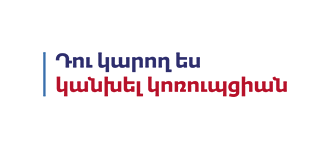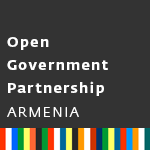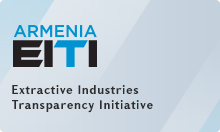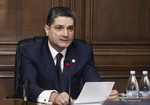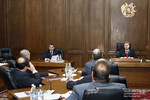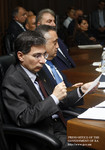Saturday, 22 May 2010
Prime Minister Tigran Sargsyan’s statement at presentation of the annual report on Republic of Armenia FY2009 State budget performance
Honorable National Assembly Chairman,
Dear Mr. Minasyan,
Dear Colleagues,
As stated above, I shall try to assess the outcome of those actions implemented during the difficult year of 2009.
Later on my colleagues will give details of 2009 State budget performance indicators and a summary description of relevant budget processes.
Our financial and economic systems underwent a stability test in 2009. The global financial and economic crisis caused us to resort to non-standard measures by updating the government’s toolkit and methodologies so as to adapt them to new economic realities.
As you may know, the global crisis made itself felt in Armenia as early as in October, 2008, with the fall reaching its peak in July of 2009. Here, it should be noted that the economic situation proved significantly aggravated by the pre-crisis GDP structure with its 27% share of capital construction, 61% of which or 16.4% of GDP fell on non-productive housing development. 75% of housing construction was done with private funds mainly coming from Russia. As a result as coupled with shrinking remittances and lower demand for real estate, capital construction dropped by more than 40%, accounting for 11% of last year’s 14.2% overall downturn. In the meantime, the second most important factor behind the drop of GDP - net indirect taxes – contributed only 2 percentage points to the fall. Thus, the stated 14.2% downturn was chiefly caused by the aforementioned two adverse factors.
We drew the following key lessons. Firstly, insufficient diversification adds to the vulnerability of our economy. For instance, the overwhelming share of construction in the GDP was a strong handicap and we will have to address this negative factor by means of diversification in future. Secondly, last year’s 20% decrease in net indirect revenue testifies that tax administration clearly needs improving necessary for ensuring better conditions for the development of other sectors based on equal terms of competition for all participants.
The Government’s anti-crisis program was submitted to the National Assembly on November 12, 2008. As a whole, the program implied additional efforts aimed at identifying and introducing new incentives for fostering economic growth and bringing stability into Armenia’s macroeconomic and financial sectors.
To maintain macroeconomic stability in 2009, almost all government initiatives were aimed at expanding fiscal policy amid decreased tax revenue in order to counteract the negative impact coming from the outer world and nurture business activities at home. The budget deficit in 2009 rose to 7.4 % due to such policy. It was a decade-high level of deficit. This means we have abided by a policy line implying that the State should not cut down spending. Therefore, we made extra borrowings to increase foreign indebtedness. As a result, the whole range of our social commitments was met. In these conditions, we managed to raise pensions by 16 %, coupled with 11% increase in average wages. Despite the fall and, as a consequence, the decline in fiscal revenue, we succeeded to carry out all our social obligations easing crisis-caused social tensions. Thus, pension funds proved at AMD 177.5 billion in 2009, or 16 % more than in 2008.
In an effort to give effect to its anti-crisis programs, the Government attracted the following resources from donor organizations:
• The World Bank gave USD 760 million of which 350 million was received in 2009;
• USD 500 million was attracted due to cooperation with the IMF;
• USD 80 million was made available by the Asian Development Bank;
• An arrangement was achieved with the European Union on Euro 100 million worth of budget support;
• USD 500mn came from the Russian Federation for funding anti-crisis actions.
As a result, the foreign debt-GDP ration rose to 36% as of 2009 against 13.2 % in 2008 which provided a “pillow” for the Government to conduct an anti-cyclic policy.
The Government had 2 simple and clear-cut directions in mind when implementing anti-crisis actions:
1. Realization of job-oriented infrastructural projects to promote GDP growth, nurture economic activity over a short-term period, as well as to provide for increased efficiency and growth of productivity in the long run building up a solid groundwork for long-term economic growth.
2. Business environment improvement, SME and system-building enterprise support
The following infrastructure-related activities were carried out in 2009:
• 411-long road sections were rehabilitated in the Republic as compared to 163 km in 2008, of which 112 km – with treasury funds and 299 km – with the help of attracted funds.
• Drinking water supply-related investment programs ensured construction of over 350 km-long water mains, more than 100 regulatory water basins, over 50 pump-stations in 2009. In parallel, over 5000 household connections were made. As far as irrigation is concerned, 50 km-long canals were built under different investment programs. As a whole, a total of AMD 16bn was made available for the betterment of drinking and irrigation water supply conditions nationwide.
• In April 2010, Yerevan TPP was re-commissioned after reconstruction. It now uses 2.5 times less natural gas than before thus reducing the cost price of electricity. This made it possible to keep down electricity tariffs amid increased cost of gas.
• Capital repair and construction of 266 facilities was carried out last year to a total cost of AMD 17bn, with AMD 14bn spent on construction and rehabilitation of some 227 educational facilities.
• 22 blocks of flats consisting of some 1056 apartments were built in the city of Gyumri, with 220 residential buildings built in Spitak. The State budget funded construction of 3 apartment houses in the city of Stepanavan. In the meantime, civil work was completed on 20 apartments in building N34 in the city of Maralik. As a result, 42 and 20 earthquake-hit homeless families got housing in Stepanavan and Maralik respectively.
• Under the Housing through Certificate program, 63 households solved their housing problems. As a whole, a total of AMD 25 billion was earmarked for construction activities in the disaster zone.
The following business environment-improvement and real sector-strengthening activities were carried out in the period under review:
Tax and customs sphere:
• Tax administration-related regulations were considerably eased for the business community and for small and medium-size enterprises, in particular, providing a higher VAT threshold of up to AMD 58.3 million instead of the formerly applied threshold of AMD 3mn. Note that over 30 thousand entities will be benefiting from this new regime in the Republic of Armenia. Tax return submittal requirements have been largely simplified for those small and medium-size enterprises with AMD 100 million worth of annual turnover.
• The threshold for monthly VAT return submittal requirement was raised from the former AMD 60mn annual turnover to AMD 100 million. The above actions will help save time and operating costs for our businessmen minimizing the contact area with tax authorities.
• A deferment of up to 3 years on VAT payments is available for commodity imports exceeding AMD 300mn as specified in Article 61 of the RA law on Value Added Tax. The Government has already approved 7 such investment programs. As a whole, about AMD 17.5bn worth of investment has already been carried out under this program to generate about 500 new jobs.
• AMD 18.7bn was refunded to exporting entities during last year. The specified resources helped them withstand the financial and economic crisis offering strong incentives for continued effective activities.
• The number of documents and procedures required for export of some goods was reduced significantly. The inventory of goods subject to mandatory certification at the time of import was reduced from 65 to 16.
The foregoing measures helped improve the business environment in the Republic of Armenia in 2009 leading to our country’s 7-point advance in standing (from 50 to 43) on the World Bank’s Doing Business chart.
Real sector
• Under the “State support for agricultural land users” program high-mountain rural communities got AMD 1.57 billion worth of support for grain crops in 2009 leading to 14.3 % growth in grain crop areas.
• The total budget of those growth-targeted programs financed from different sources and approved by the Operative Staff rose to 39 billion drams. All relevant drafts and decisions are posted on the government’s website for public control.
• The Operative Staff decided to provide AMD 3,5bn worth of budget guarantees to 65 developers in 2009. By the time the guarantees were issued all target facilities had 70% completion status which rose to 95% afterwards. One of beneficiary companies has completed construction work. A total of about 450 jobs were created owing to the government’s intervention.
• Part of the 185 billion worth of Russian credit has been earmarked as follows: 50 billion in disaster zone activities and about 113 billion in loans and business support of which over 96 billion drams in actual financing. AMD 20bn went to small and medium-size enterprises, with more than 32 billion spent on export incentives through CBA-administered lending available to processing and infrastructure-building enterprises via the Armenian-German Fund.
• The above-stated 32 billion has already been repaid in full. Note that interest paid by the private sector for the use of this loan was much higher than the one at which the Russian credit was attracted, which means that the Russian credit will not give rise to significant budget pressures. At the same time, it seems to be a more affordable source of borrowing for the private sector which has helped bring down interest rates allowing easy access to lending in the Republic of Armenia. Besides, we have set up a stabilization fund with the Central Bank to ensure higher return on domestic resources and greater efficiency in foreign debt management.
• The National Mortgage Company UCO was launched to deal with the population’s welfare problems. The UCO has since refinanced mortgage loans to the amount of AMD 4.4bn.
To provide young families with sustainable housing, the government decided to subsidize part of interest on mortgage loans in line with the RA President’s electoral platform.
Our anti-crisis program effectiveness can well be assessed based on the level of bank financing of the economy. Thus, despite the decline of GDP, economic lending rose by 16% to AMD 735bn in 2009. This is a record performance both among CIS and other countries. First of all, it speaks of our banks’ readiness to defy the crisis thanks to high level of capitalization and liquidity. Unlike other countries, Armenian banks did not get any support from the State. Moreover, they helped us cope with the negative impact of the global crisis.
Standing loans to agriculture totaled AMD 44.1bn as compared to 36.5bn loans of 2008, which is a 21% growth.
Thus, we can state that the government‘s anti-crisis measures provided a solid groundwork for economic recovery.
As a result, we were able to shift the downward trends of the first half of 2009 ensuring favorable conditions for economic growth in 2010.
Thanks to the government’s anti-crisis action, last September’s 18.3% decline was brought down to 14.2 % by yearend, with 7.2% growth recorded in April, 2010. It is noteworthy that this improvement was due to some 12.9% growth in industry testifying to the effectiveness of those structural transformations operated by the government throughout last year.
As we are only a month off the end of the second quarter, I deem it important to refer to those programs scheduled for implementation in 2010:
• The 5th unit of Hrazdan TPP will be commissioned this fall to a total cost of USD 450mn. Its output will be exported in full to improve Armenia’s trade balance considerably.
• New NPP construction preparations are underway, and a feasibility study will be prepared by the project manager over the next few months.
• AMD 24bn will be invested in the disaster zone this year into the construction of 1600 new apartments.
• Based on the feasibility study report, design and cost estimate documents are being prepared for the north – south road corridor project, with USD50mn worth of activities set to be carried out during this year.
• Talks are underway with the investors on north – south railway construction, and we are going to announce the startup of the activities in 2010.
• Irrigation-, water supply- and water drainage-related projects are being implemented to a total cost of AMD25bn. They are supposed to help raise competitiveness in agriculture. Note that the stated budget is 50% higher than that of 2009.
• Tatev monastic complex rehabilitation work will have been completed by this October to give a strong boost to regional tourism.
In conclusion, I wish to extend a vote of thanks to the National Assembly which was instrumental in giving effect to all these programs by adopting corresponding legislative packages and ratifying international loan covenants, as well as by contributing with its own anti-crisis initiatives.
Thank you.

